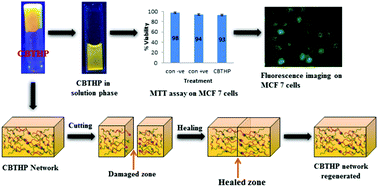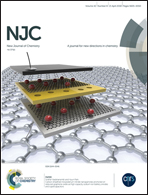A dynamic sugar based bio-inspired, self-healing hydrogel exhibiting ESIPT†
Abstract
The development of a bioactive hydrogel that acts as a cell carrier can overcome current limitations in cell therapy. However, the hydrogels usually have a tendency to get damaged during use, and they sometimes also pose a real threat of cell apoptosis. Therefore, the present work has been performed to develop a bio-inspired, self-healing chitosan-5-(benzo[d]thiazol-2-yl)-4-hydroxyisophthalaldehyde (CBTHP) fluorescent hydrogel. The physico-chemical properties of this polymeric hydrogel have been characterized by using FT-IR spectroscopy, solid state 13C NMR, rheological analysis, SEM, TEM, DLS, UV-Vis spectroscopy, fluorescence spectroscopy, TGA and swelling study. CBTHP exhibits ultrafast excited state intramolecular proton transfer (ESIPT) through keto–enol tautomerism in both the gel and solution phase. The dynamic equilibrium between the Schiff base linkages between the aldehyde and amine reactants introduces the self-healing property in the hydrogel. The self-healing property of the hydrogel has also been monitored by rheological analysis through step-strain measurements (strain 0.1 to 100%) at 25 °C. The polymeric hydrogel network exhibits a reversible sol–gel transition for several cycles owing to the dynamic equilibrium between the Schiff base linkages. The cellular uptake and cell imaging efficiency suggest that as compared to other fluorescent materials, the formulation of this bio-inspired hydrogel can enable more molecules to enter the cells and thereby causing a greater intensity of fluorescence.



 Please wait while we load your content...
Please wait while we load your content...